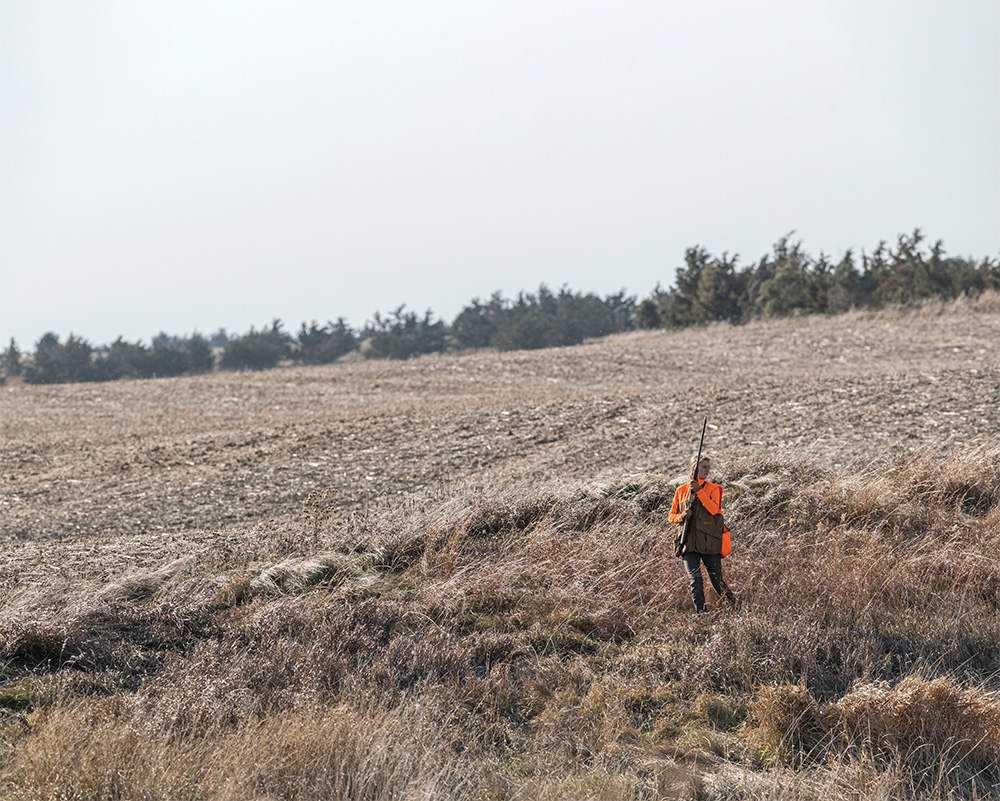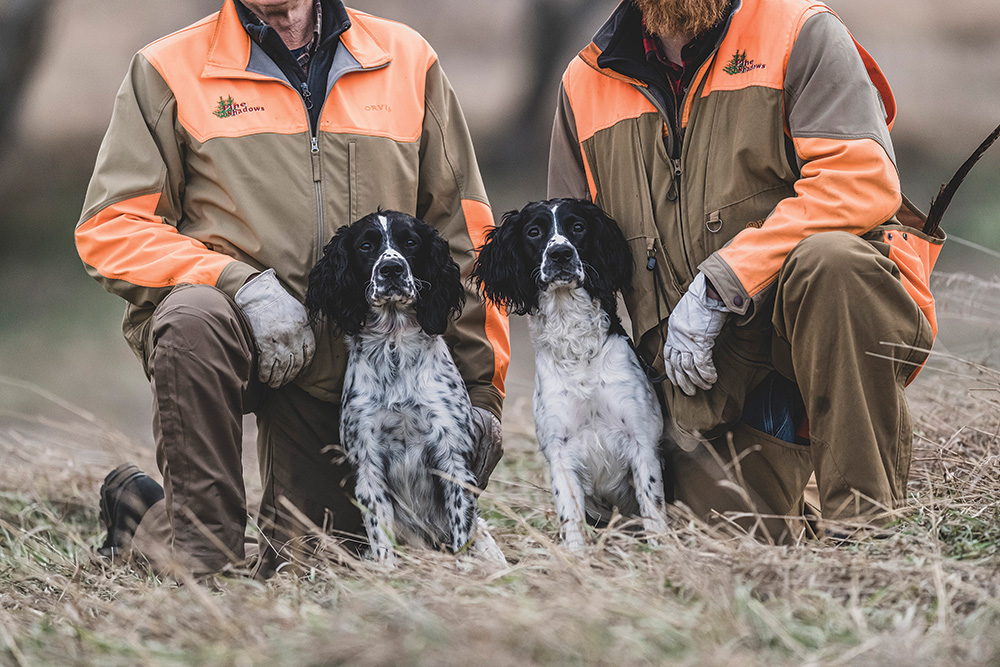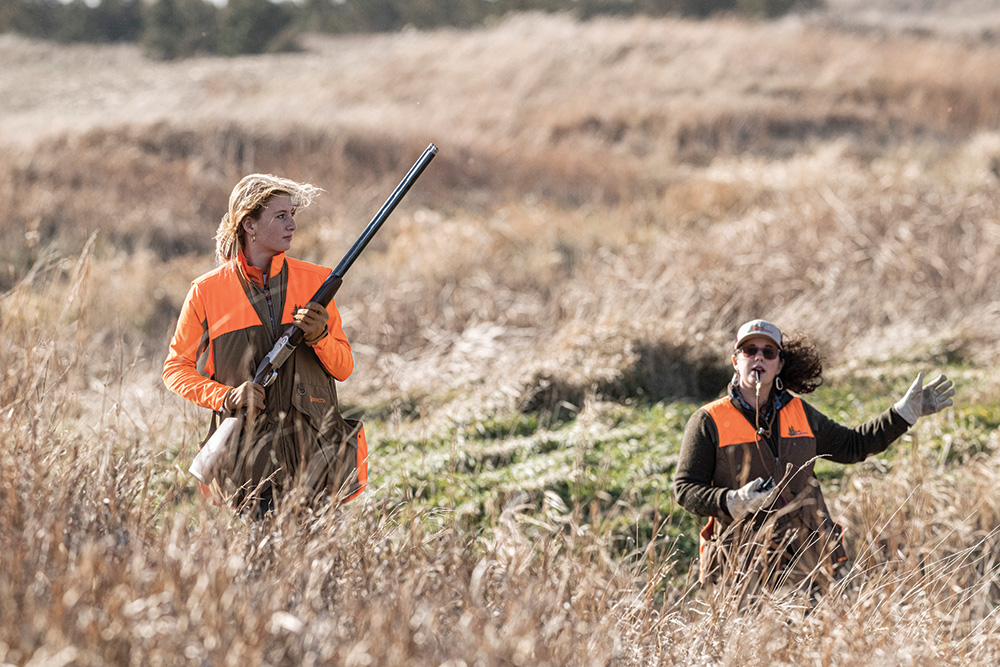Time and Place to Reflect

The fleeting hours of the sun at that time in that place were comprised of varying moments of struggle and elegance, all in equal parts. A girl in her late teens walked the rolling grasslands with determination in her legs and wonder in her eyes and hope in her soul for what may come. Her gloved hands firmly held an over-and-under shotgun given to her by her father, a tool that was loaded and at the ready. She wore a tin-packer hat to hide her face from the sun. And from underneath, the brutal wind fiercely blew the long, blonde hair behind her.
The flatlands of Central South Dakota lack the topography to impede such conditions. Pheasants restrain their instinct to fly in untamed winds. Hunters almost step on birds to flush, yet fail to hear the cackle when they do. But when the game takes wing, feathers catch the fast air with that signature, flowing, long tail waiving goodbye at the escape, turning to a mere blur in a heartbeat on the horizon. Despite the difficulty, the girl remained steadfast, determined to succeed.
As the hunters approached the spot on the map named J.P.’s Corner, two women guided the hunt along the fields of brassicas and food plots, masterfully commanding their eager springer spaniels with whistles as necessary. But this rarely happened, as the dogs were well-trained and primed for this very moment. The pace was brisk and lively, yet well under control. The anticipation of a flushing rooster was intense and palpable with every cast of a dog through the cattails and step of a boot in the grass. This was upland hunting the way it was meant to be.
The group turned toward Heaven’s Gate on their way to Seth’s Trees where the dogs signaled what the hunters had hoped for. You know the cue: a head down with a heightened pace and frantic short tail circling in the air. The pheasants were hiding from the elements in the stand of young conifers, and the young girl walked on the downwind side. As the springers expertly flushed a rooster toward her, she skillfully raised her gun, smoothly swung from left to right, and felled the bird with feathers flailing in the wind as if she’d done the same many times before. However, this was her first.
When the walk was over, the young girl held the treasured rainbow colors of three birds in her hands, standing by her father, both reflecting upon more hits than misses together that afternoon. Mark Haglin, owner of Pine Shadows Daybreak, stood stoic nearby with a smile on his face, showing his pride in giving back to the next generation of hunters. The day’s miles, wrought with wind and cold, signified its struggle, while its elegance was found in the food and fellowship to follow.

Sometimes the uplands reveal times and places for us to reflect upon what matters in life. The lessons may lie in learning the history of the lands upon which you hunt to harvest the wildlife these lands bestow upon you. Maybe you truly understand the experience of the here and the now with your family and friends who mean the most to you. From the serenity and sincerity of the situation, you just may be inspired to give back to the resource that needs your help to perpetuate the future of the hunting and the habitat and the wildlife we love.
From sunup to sundown, places like this cause you to reflect. At every turn of the day, you inexplicably connect with the people and the nature around you. Pine Shadows Daybreak is the pinnacle example of such a place, where the people truly understand the value of upland hunting and the power it has for us now and will, hopefully, forever.
We must first reflect upon those who came before us. The Daybreak grounds skirt along the winding Elm River on dirt homesteaded in 1881 by John Turnquist, a Swedish immigrant, who traveled west and settled where he could raise cattle on the fertile ground and grasslands of the Elm River Valley. On this land, John made a living turning soil and feeding the farm animals to provide for his wife and nine children living through the harsh South Dakota winters in a two-room, wood-framed house built near the location of where the Daybreak lodge is today.
Just minutes to the east at a gravel crossroads, a historical monument adorns the valley, reading: On this spot stood Colon Campbell Fur Post 1822-28. The very important Sioux, Waneta was born near this place 1794-1848. The fur post (actually spelled “Colin” Campbell) was strategically located in this valley to trade with the local Indian tribes of the time. A prominent Dakota Indian chief, Waneta was born around 1795 and fought for the British against the Americans in the War of 1812, where it is said he killed seven men in hand-to-hand combat. After the war, he was invited to cross the ocean to visit England and met with King George III who rewarded him for his loyalty with a commission. Following a life-threatening encounter with the Americans at Fort Snelling in Minnesota, he changed his allegiance to the United States. He was killed at the age of 44 by one of his own tribesmen in North Dakota, just across the border from his birthplace. This area was, and still is, important to the Dakota Indians.
Seven miles to the northeast, as the crow flies, is the prairie town of Frederick, South Dakota, which was founded in 1882. A little research shines some light on the history of the people who settled this village and its surrounding lands. A marketing poster and map, labeled “Birds Eye View of Frederick, Dak. 1883” created to encourage commerce in the West, proclaims Frederick to be “The Finest Town in South Dakota.” The effort goes on, “…and in its first year of existence, rapidly developed in size and prominence, now numbering 700 in population and many solid business enterprises.” The population number is interesting as historical records actually show the population to be 281 in the late 19th Century, which is more than the current population of 196 as of 2020.
The map of Frederick shows the railroad depot for the H&D Railroad Company (which was soon to be connected to the Northwestern Railroad from Bismarck, North Dakota) for travel and commerce, a grain elevator for the farmers, and a schoolhouse for the kids. There was one jeweler, banker, blacksmith, grocery, and drug store. With three general stores, two lumber yards, two real-estate agents, and two lawyers in this extremely small town, the opportunity of the West and competition for business was apparent for the time. The little village also supported two different newspaper firms in such a new place, which signifies the importance of news and communications and messaging during the Western migration of the 19th Century.

By a red bus adorned with the words “Pine Shadows” in white, Mark Haglin stood admiring the effort of the day by the guides and dogs and a young girl holding her special prize. He is well aware of the history of the struggle of living off of the land and of running a small business and of how necessary marketing and communications are for his livelihood. His Akubra hat tipped downward to shade his eyes, but the smile was accented by the sun. Whenever this man’s mouth moves, his words mean so much…and people listen. He congratulated all hunters for the good shooting, but for him, the hunt was not all about the number of birds to clean at the end of the day.
In a sense, Mark overlooks the landscape and community as a staunch and unwavering guardian for the future of so many things—from defining effective dog training and fostering the ambition of young hunters to protecting the populations of the birds themselves. There is not enough space in the magazine to comprehensively cover the effect Mark Haglin and his family have had upon the upland-hunting community and the future of it. There is his Pine Shadows business near Brainerd, Minnesota, English springer spaniels, dog breeding and training and trials, hunter recruitment, youth events, and conservation support, all in addition to the Daybreak hunting experience.
Daybreak gives the Haglins a signature hunting lodge in a prime location to showcase their business of pheasant hunting and training dogs and conservation. The Daybreak grounds consist of an 11-square-mile estate with the home base secluded in an intimate setting. The lodge is a beacon in the valley peaked with vintage wind turbines and a flowing American flag on top. It is hidden along the Elm River between ridges on both sides, yet hunters who approach down the gravel driveway see a prominent, white-painted structure that beckons those who arrive to wonder what stories are told within. The remodeled barn was constructed with care, bringing a rustic feeling that pays homage to the history of the lands along with a bit of private luxury for an extremely comfortable and peaceful feeling following a day afield.
The warm food can be found within a short walk from the lodge to another white building with a sign reading “POST Est. 1822” above the swinging screen door. Inside, Chef Rachel Hogan showcases her love for wild game while serving three meals a day for hunters and guides. There, you’ll enjoy all of Rachel’s creativity and devotion to her craft, everything from Eggs Benedict in the morning, Daybreak’s Pulled Pheasant Sliders, and a heartwarming Pheasant Pot Pie. Not only will Rachel cook some of the finest wild-game dishes, but she is a bird-dog owner herself and guides hunters afield every chance she gets.
In addition to the history and the place and the food, we also must reflect upon the people that affect us most. Mark’s wife, Sophie, directs the breeding and puppy program for their English springer spaniels. Since 1976, Mark and Sophie’s philosophy has been to produce the best gun dogs for both the field and the home. This starts with Sophie whelping and caring for all puppies inside the Haglin’s own house. Their son, Morgan, is known nationwide as a professional dog trainer, dog trialer, and trial judge in his own right and leads the charge for the Pine Shadows training and guiding programs. If you spend any time with the Haglin family and the rest of the Pine Shadows crew, you’ll also get to know Lynn and Joannie Peterson, Chef Rachel Hogan, Peyton Loss, Tony Cyr, and many others who all play an integral part in making Pine Shadows Daybreak a special place.
Let’s reflect upon the dogs themselves, because without them, where would we be? The springers of Pine Shadows were featured in Covey Rise magazine in 2015 with the coveted dog named “Sister” on the cover. Dogs that hunt at Daybreak advance through the Pine Shadows puppy and training programs. For puppies, new dog owners receive a satisfaction guarantee—where the dogs are guaranteed for hunting ability, health and temperament, conforming to lifestyle, and becoming an important part of the new family. These are high standards, and Pine Shadows dogs deliver. The team has been training all breeds for over four decades with numerous graduates of their tutelage becoming field champions and master hunters, with hundreds of lifetime hunting companions for hunters proud of their dog in the field or the duck blind. The springers of Pine Shadows were the first springer-spaniel kennel selected for Orvis endorsement.
Hunts at Daybreak are truly pheasant hunts of a lifetime. Only a select few groups of hunters will grace the prairie fields of Daybreak each season. For those able to embrace the challenge, the springers will flush scores of wild pheasants in highly managed upland habitat for an ultimate wingshooting experience. Mark once said, “Our heritage spans over four decades. We are consistently refining our ability to communicate quality with our English springer spaniels, priding ourselves on the attention, education, and personal detail given to every client, employee, and our community. We take responsibility for the quality of the hunting world, not only for today, but for tomorrow.”

No matter the origin of the source of your inspiration, there is a time and a place to reflect upon why it resonates with you and leaves lasting memories. This is where you embrace the coming struggles of the day with a fervor as the sun rises. You live for the exertion of the endeavor to conquer the natural challenges the land presents with every step. Upland hunting is not easy. The days are long. The terrain strains your inner energy. You fight to persevere. However, this duel with yourself and nature is why you love it. Because you welcome the strategy and science inherent in the conflict.
This is the essence of Daybreak—a time and a place to re-flect upon the glorious struggles of the day amidst the intimate elegance of the sun setting over the ridge beyond the fire when it’s over, where the flames illuminate the shining eyes and wide smiles of those around you after the dogs are fed and resting. The tales told are more profound than normal as the outside’s silence amplifies upon the sound of a storyteller’s voice.
After the fine meal nourished their souls, the girl and her father warmed near the fire in the valley to share their stories together as the silhouettes of the evening’s deer appeared on the ridge beyond, and cackling pheasants flew to the roost one by one. This moment is why we do what we do. We must create these memories now so that just maybe, most hopefully, those new to the traditions reflect upon them with smiles and motivation of their own.
And as Mark Haglin eloquently said, we must care for the future of all of it. Without people to carry the torch of the Pine Shadows mission, where would we be with the traditions we wish to protect? If we fail, a moment like a springer flushing a wild ringneck for a young girl to make a valiant shot through the strong winds with the hugs of her father to follow…that moment may be no longer. And we never, ever want that to be forgotten.
Originally published in Volume 10, Number 2 (February-March 2022) of Covey Rise.
























